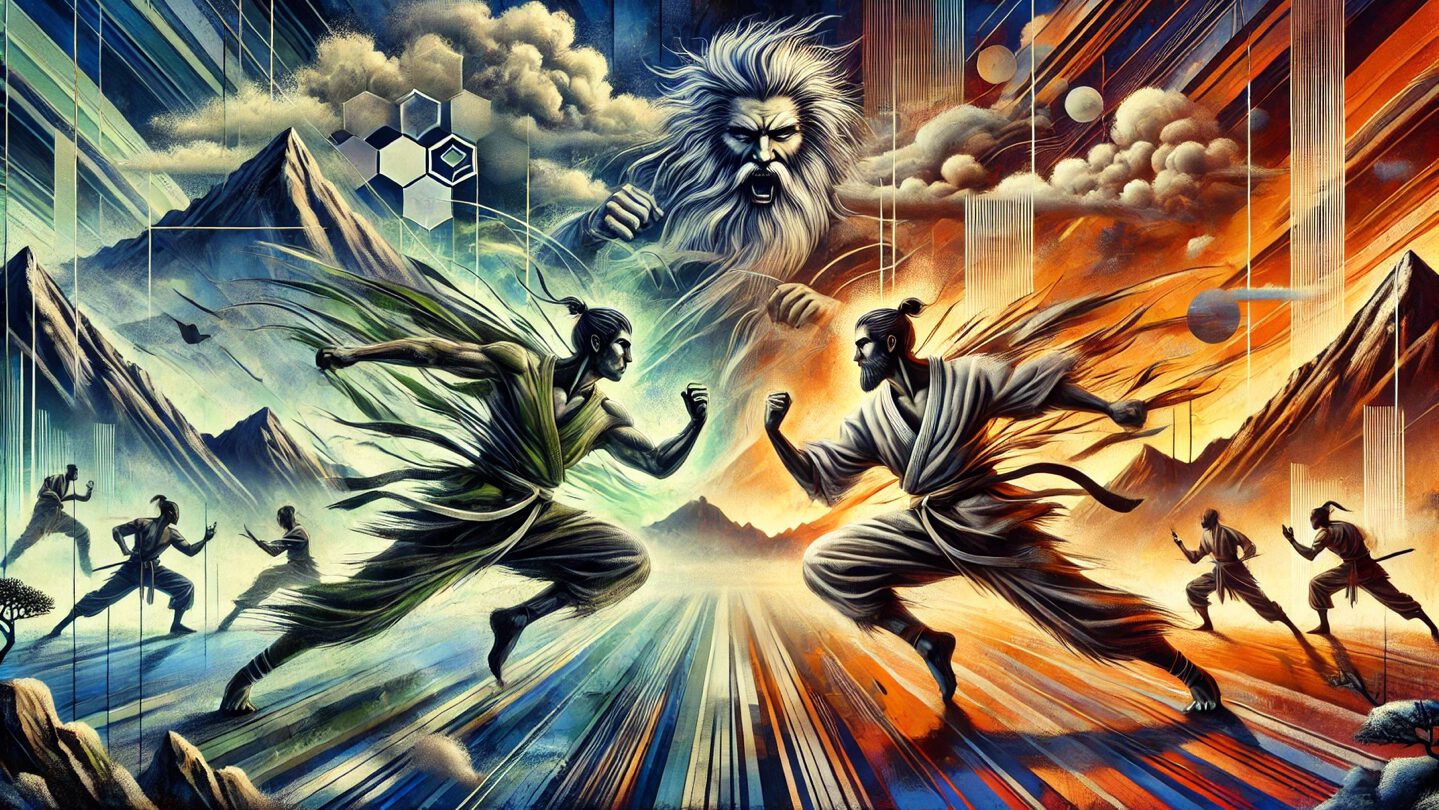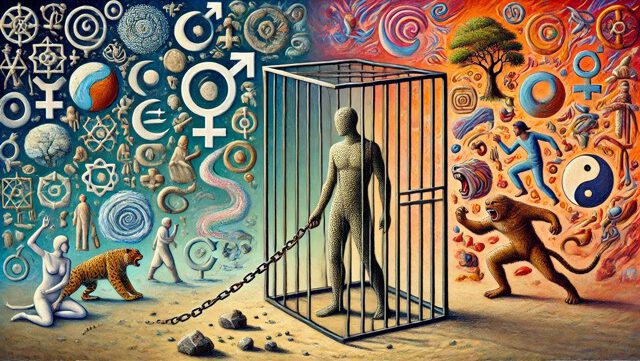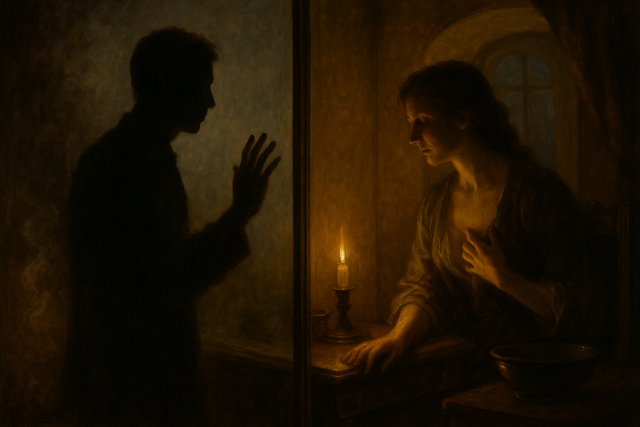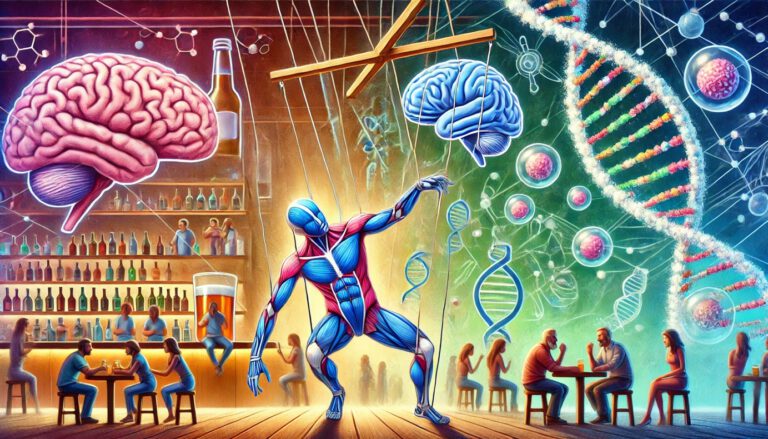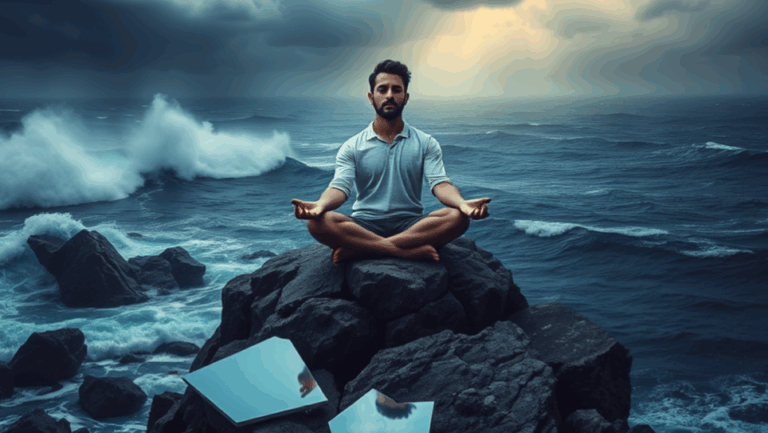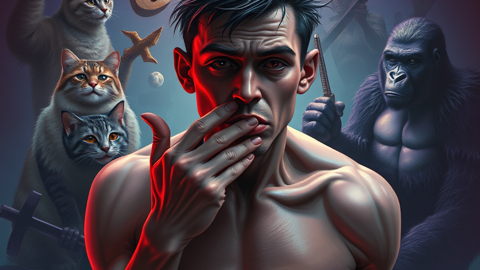Waarom kiest de mens ervoor om vrijwillig klappen te incasseren of uit te delen in georganiseerde omgevingen? Of het nu in een boksring, een dojo, of een kleedkamer vol trots is, vechtsport belichaamt meer dan fysieke strijd: het is een sublimering van diepgewortelde driften en culturele constructies. Zoals Sun Tzu ooit stelde, is oorlog een kunst, en deze kunst heeft zich in onze moderne tijd vertaald naar gecontroleerde arena’s waarin chaos wordt geordend en geweld wordt gereguleerd.
Vechtsporten zijn daarmee een microkosmos van de menselijke conditie, waar instincten, statusdrang en cultuur samenkomen. Dit artikel verkent hoe vechtsport zich verhoudt tot het credo “Omarm je naasten, vernietig je vijanden en verslaaf de anderen”, en plaatst het binnen de bredere context van menselijke drijfveren en paradoxen.
Omarm je naasten: Strijd als Sociale Binding
Vechtsporten ontstaan in een sociale context. Ze zijn niet alleen een middel tot competitie, maar ook een ritueel dat sociale cohesie bevordert. Binnen een club of team zijn de regels, rituelen en gezamenlijke doelen instrumenten om verbondenheid te creëren. De sparringpartner wordt een bondgenoot, een spiegel die je sterker maakt.
- Neurobiologisch fundament: Agressie en samenwerking zijn onlosmakelijk verbonden. Dezelfde neurale systemen die agressie reguleren, versterken ook sociale binding wanneer die agressie wordt gekanaliseerd binnen een veilige context.
- Culturele rituelen: Historisch gezien waren gladiatorenspelen en riddertoernooien niet alleen bloedige spektakels, maar ook sociale evenementen die gemeenschap creëerden en hiërarchieën versterkten.
Binnen dit deel van het credo ligt de kracht van vechtsport als sociaal cement: wie samen strijdt, blijft samen.
Vernietig je vijanden: Competitie en Dominantie
De arena is niet alleen een plaats van verbinding, maar ook van confrontatie. Hier wordt het tweede deel van het credo zichtbaar: de strijd om dominantie en erkenning. Zoals Machiavelli stelde, is macht de kern van menselijke interactie, en in de vechtsport wordt dit krachtenspel tot op het lichaam gevoerd.
- Fysieke en psychologische dominantie: Het gevecht draait niet alleen om fysieke kracht, maar ook om strategie en mentale weerbaarheid. Zoals Foucault’s concept van biopolitiek aangeeft, is het lichaam zowel een instrument als een doelwit van macht.
- Onvoorspelbaarheid: De spanning in een gevecht zit in de onzekerheid. Het is precies deze onzekerheid die de aantrekkingskracht van de competitie vergroot, zowel voor de deelnemers als de toeschouwers.
Hier botsen biologie en cultuur: instinctieve drang naar overleving wordt verfijnd tot sportieve strijd met regels en normen.
Verslaaf de anderen: De Industriële Exploitatie van Strijd
De moderne vechtsport is ook een commercieel fenomeen. Het derde deel van het credo – verslaving creëren – is sterk aanwezig in de wereld van gevechtssporten, waar competities en merchandise drijven op de fascinatie van het publiek.
- De verslaving aan competitie: Voor de vechtsporter zelf is training een levensstijl die zowel discipline als een constante drang naar verbetering vereist. De toeschouwer, aan de andere kant, wordt verslaafd aan de adrenaline van de competitie, gestimuleerd door media en marketing.
- Technologie en vereeuwiging: Sociale media versterken dit proces door vechtsporters te transformeren in idolen, wiens prestaties worden gevierd en gecommercialiseerd.
Deze commerciële kant toont hoe strijd niet alleen een fysieke daad is, maar ook een instrument van kapitalistische exploitatie.
Het Agon-Motief: Strijd als Overlevingskunst
Vanuit een evolutionair perspectief is strijd altijd een middel geweest om te overleven en dominantie te verkrijgen. Dit agon-motief, zoals Johan Huizinga in Homo Ludens beschrijft, is de drang om jezelf te bewijzen in een competitieve setting.
- Van oorlog naar spel: Waar strijd ooit ging om leven en dood, heeft de beschaving dit geweld gesublimeerd in spelvormen. Norbert Elias’ beschavingstheorie legt uit hoe geweld wordt getemperd door regels en normen, zoals zichtbaar in vechtsporten.
- Prestige en paringssucces: In lijn met Darwinistische principes fungeert succes in de competitie als een signaal van fitheid, wat status en toegang tot partners bevordert.
Strijd is daarmee zowel biologisch verankerd als cultureel verfijnd.
De Mythe van Vrijheid in Vechtsporten
Vechtsport belooft vrijheid – controle over lichaam en geest – maar deze vrijheid is een illusie. Zoals beschreven in het oorspronkelijke credo, wordt de mens voortdurend gevangengehouden door zijn eigen driften en de systemen waarin hij opereert.
- Zelfbeheersing of slavernij? Training en discipline lijken vrijheid te brengen, maar maken de vechtsporter afhankelijk van regels en routines.
- Commercieel eigendom: De industrialisatie van sport transformeert de atleet in een product, een pion in een groter economisch spel.
De paradox van vrijheid is dat de zoektocht ernaar ons vaak nog meer bindt.
Conclusie: De Mens als Strijdend Dier
Vechtsporten zijn meer dan fysieke disciplines; ze zijn een culturele uiting van onze diepste biologische en psychologische drijfveren. Ze brengen het credo “Omarm je naasten, vernietig je vijanden en verslaaf de anderen” tot leven in een gecontroleerde omgeving, waar natuur en cultuur elkaar ontmoeten.
In de ring of op de mat toont de mens zijn ware aard: een wezen dat vecht voor verbinding, erkenning en controle, maar dat tegelijkertijd verstrikt blijft in zijn eigen paradoxale conditionering.
Misschien ligt de kracht van vechtsport niet in het winnen van gevechten, maar in het inzicht dat strijd een onvermijdelijk onderdeel is van wat het betekent om mens te zijn. En in die strijd, zoals in het leven zelf, ligt de werkelijke uitdaging: niet de ander, maar jezelf overwinnen.
Peter Koopman.
The English version is available here:
Man and Battle: Martial Arts as a Mirror of Nature, Culture and Paradoxical Drifts
Why do humans choose to voluntarily take or deal blows in organized environments? Whether in a boxing ring, a dojo, or a locker room full of pride, martial arts embodies more than physical combat: it is a sublimation of deep-seated drives and cultural constructs. As Sun Tzu once argued, war is an art, and this art has translated in our modern age into controlled arenas in which chaos is ordered and violence is regulated.
Martial arts are thus a microcosm of the human condition, where instincts, status drives and culture converge. This article explores how martial arts relate to the credo ‘Embrace your neighbours, destroy your enemies and enslave the others’, and places it within the broader context of human drives and paradoxes.
Embrace your neighbours: Combat as Social Bonding
Martial arts arise in a social context. They are not only a means of competition, but also a ritual that promotes social cohesion. Within a club or team, rules, rituals and common goals are tools to create connectedness. The sparring partner becomes an ally, a mirror that makes you stronger.
– Neurobiological foundation: Aggression and cooperation are inextricably linked. The same neural systems that regulate aggression also strengthen social bonding when that aggression is channelled within a safe context.
– Cultural rituals: Historically, gladiatorial games and knightly tournaments were not only bloody spectacles, but also social events that created community and reinforced hierarchies.
Within this part of the creed lies the power of martial arts as social cement: those who fight together, stay together.
Destroy your enemies: Competition and Dominance
The arena is not only a place of connection, but also of confrontation. This is where the second part of the creed becomes visible: the struggle for dominance and recognition. As Machiavelli argued, power is at the heart of human interaction, and in martial arts this power play is carried right down to the body.
– Physical and psychological dominance: combat is not only about physical strength, but also about strategy and mental resilience. As Foucault’s concept of biopolitics indicates, the body is both an instrument and a target of power.
– Unpredictability: The tension in a fight is in the uncertainty. It is precisely this uncertainty that adds to the attraction of competition, both for participants and spectators.
This is where biology and culture collide: instinctive drive for survival is refined into sporting struggle with rules and norms.
Addict the others: The Industrial Exploitation of Combat
Modern martial arts is also a commercial phenomenon. The third part of the credo – creating addiction – is strong in the world of combat sports, where competitions and merchandise float on the public’s fascination.
– The addiction to competition: For the martial artist himself, training is a lifestyle that requires both discipline and a constant drive to improve. The spectator, on the other hand, becomes addicted to the adrenaline of competition, stimulated by media and marketing.
– Technology and immortalisation: Social media reinforce this process by transforming martial artists into idols, whose achievements are celebrated and commercialised.
This commercial side shows how combat is not only a physical act, but also an instrument of capitalist exploitation.
The Agon-Motif: Struggle as an Art of Survival
From an evolutionary perspective, struggle has always been a means of survival and dominance. This agon motif, as described by Johan Huizinga in Homo Ludens, is the urge to prove oneself in a competitive setting.
– From war to play: Where battle was once about life and death, civilisation has sublimated this violence into forms of play. Norbert Elias’ theory of civilisation explains how violence is tempered by rules and norms, as visible in martial arts.
– Prestige and mating success: In line with Darwinian principles, success in competition acts as a signal of fitness, promoting status and access to mates.
Combat is thus both biologically anchored and culturally sophisticated.
The Myth of Freedom in Martial Arts
Martial arts promise freedom – control over body and mind – but this freedom is an illusion. As described in the original creed, humans are constantly held captive by their own urges and the systems in which they operate.
– Self-control or slavery? Training and discipline seem to bring freedom, but make the martial artist dependent on rules and routines.
– Commercial ownership: The industrialisation of sport transforms the athlete into a product, a pawn in a larger economic game.
The paradox of freedom is that the quest for it often binds us even more.
Conclusion: Man as a Fighting Animal
Martial arts are more than physical disciplines; they are a cultural expression of our deepest biological and psychological drives. They bring to life the credo ‘Embrace your neighbours, destroy your enemies and enslave the others’ in a controlled environment, where nature meets culture.
In the ring or on the mat, man reveals his true nature: a being who fights for connection, recognition and control, but who at the same time remains entangled in his own paradoxical conditioning.
Perhaps the power of martial arts lies not in winning fights, but in understanding that struggle is an inevitable part of what it means to be human. And in that struggle, as in life itself, lies the real challenge: to overcome not the other, but yourself.
Peter Koopman.

